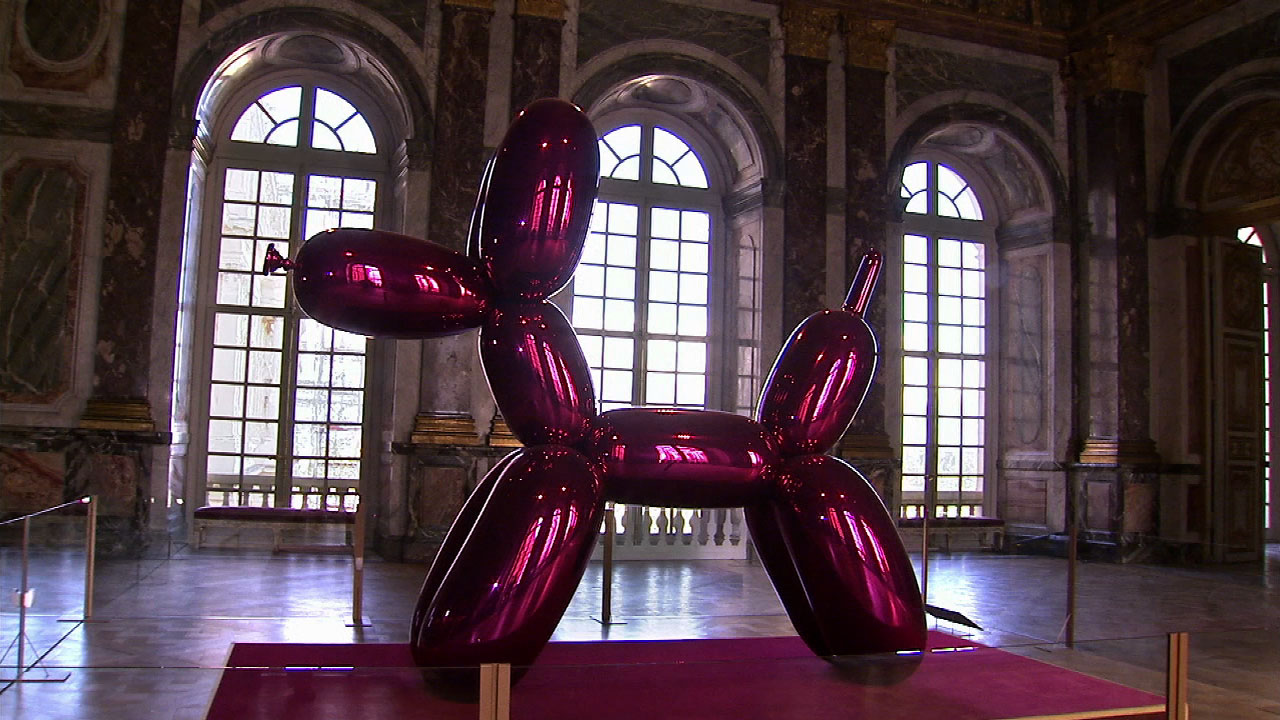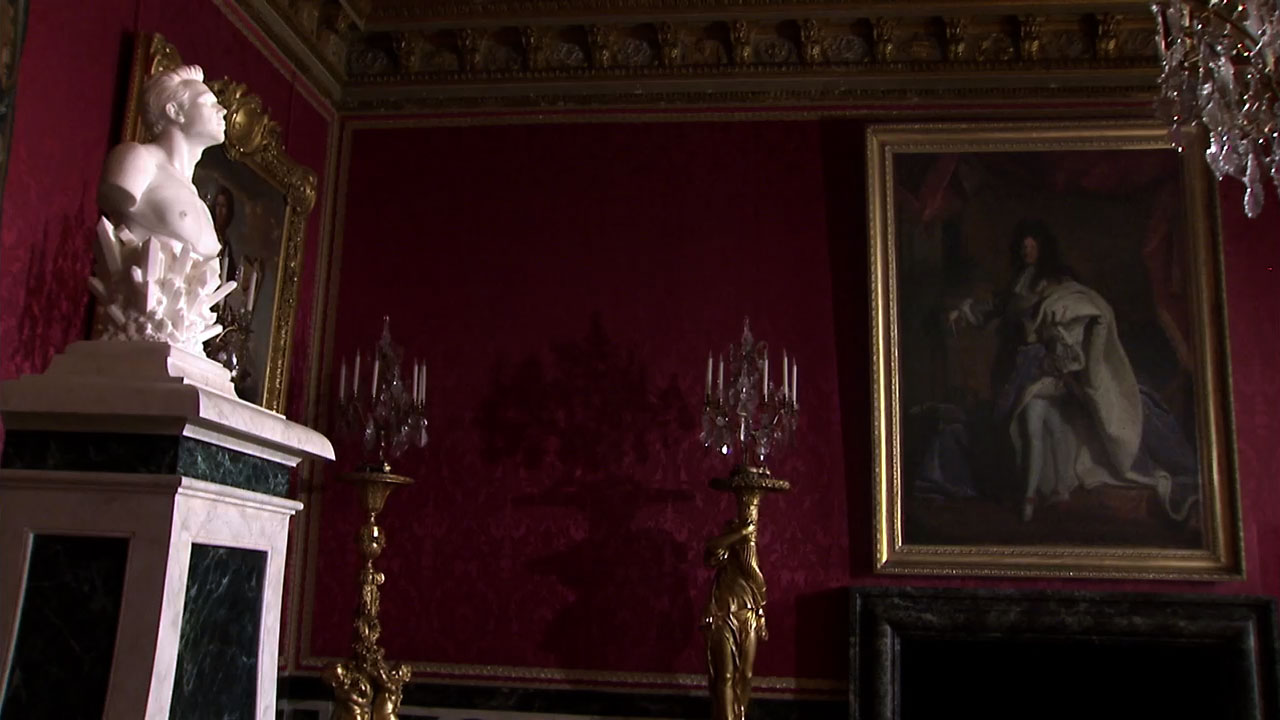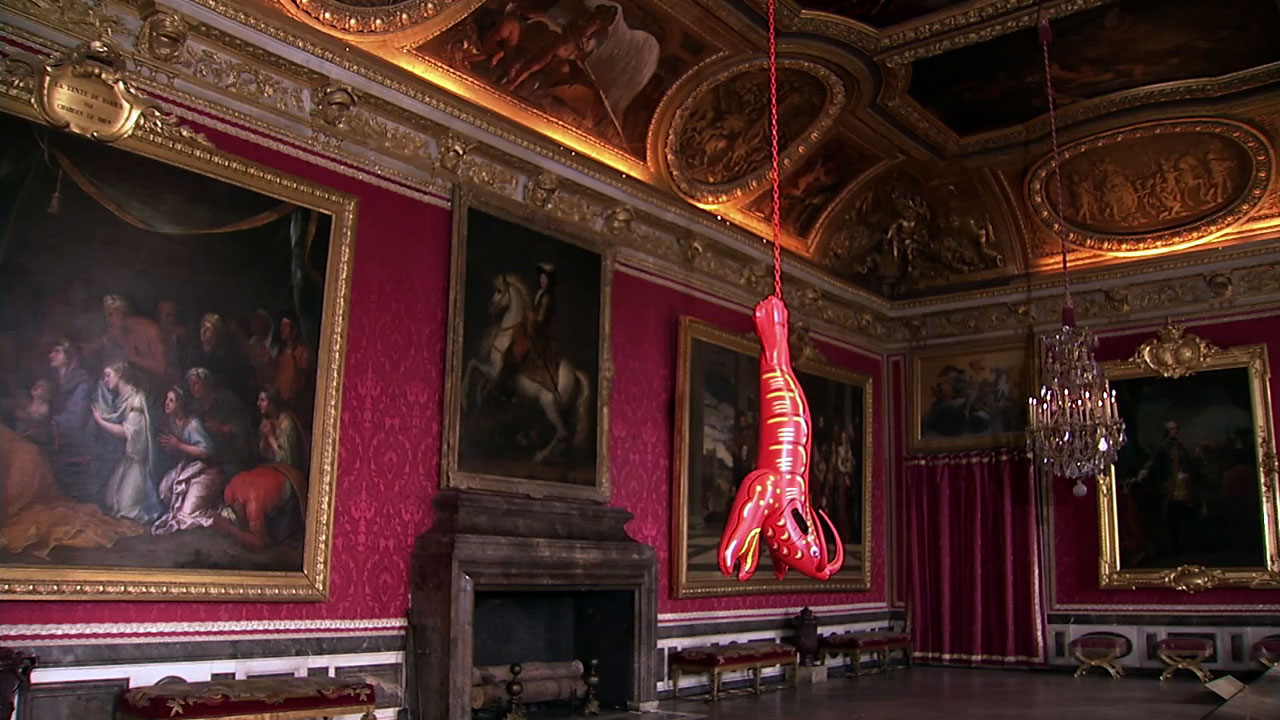Interview
Art Changes Every Day

Jeff Koons. Lobster, detail, 2003. Installation view at Château de Versailles, France, 2008. Production still from the Art in the Twenty-First Century Season 5 episode, Fantasy. © Art21, Inc. 2009.
In this interview, Jeff Koons talks about his relationship with art, his exhibition at the Château de Versailles, and misrepresentations of his work.
ART21: Talk about how your relationship with art has evolved over time?
KOONS: One of the amazing things about art is that it changes every day, and its meaning to you changes every day. When I was young, it was really a vehicle that gave me a sense of self. My sister was three years older—so I couldn’t do anything as well as she could. She could always do everything better. But when my parents saw me draw, they made me feel like I could finally do something at her level. From that point I had a feeling that I had a place, and it gave me a sense of being. I started off having no idea what the power of art could be. As I developed a sense of personal iconography I learned that you start to become comfortable with yourself, to accept yourself. Once that happens, you want to go external. You go from subjective to objective art, and art becomes a journey, which is really about sharing with people. When I was young I really didn’t have a base in art history. My first day in art school, we went to the Baltimore Museum and at that moment I realized how naïve I was. I didn’t know who Braque was. I didn’t know Manet. I knew nobody. I knew Dali, Warhol, and probably Rauschenberg, and Michelangelo, but I had no sense of art history. I survived that day and I think that’s one of the reasons I’m here now. I was hungry to learn. I wanted something to transform my life. And art has that ability to present everything in the world, all the disciplines of the world, and to unite them.
ART21: How would you describe your personal iconography, and is there something you can look back and see consistently in your work?
KOONS: Artists are asked quite often whether there’s anything repetitive in their work. If I look at all the work that I’ve done over the years, I can see that I continue with certain themes. I like flowers; I like certain sensual images. There are certain things that I like to work with: it’s really how you look at life, how open you are to life and its spiritual aspects. A lot of things come into play. If I look at a Warhol soup can or a urinal by Duchamp, these are cries of communication. I don’t think they’re about the objects. Duchamp would probably roll over on hearing this—but I think that objects are metaphors for people. So it’s not about accepting the object in high-mode culture; it’s about acceptance of others. I think what people want from art is gesture. And when I say gesture, I don’t mean just a physical gesture but a form of gesture that everybody wants to live life to its fullest and to feel life within their blood system. What does it mean, to be alive? What’s my potential? That’s what you look for from art, whether you’re looking at dance or listening to music or looking at a visual artist’s work. You want gesture: you want the person to be in the moment to show you how far you can go, and the freedom of what that means. So the job of the artist is to make a gesture and really show people what their potential is. It’s not about the object, and it’s not about the image; it’s about the viewer. That’s where the art happens. The objects are absolutely valueless. But what happens inside the viewer—that’s where the value is.

Jeff Koons. Balloon Dog (Magenta), 1995–2000. Installation view at Château de Versailles, France, 2008. Production still from the Art in the Twenty-First Century Season 5 episode, Fantasy. © Art21, Inc. 2009.
ART21: Is that, coupled with your own pleasure in making things, what motivates you?
KOONS: I’ve always enjoyed interacting with people. From the time that I was a child, I would take care of myself. I was brought up to be really self-reliant. I would go door-to-door, selling gift-wrapping paper, candies, chocolates—and I always enjoyed that I never knew who would open the door. It’s the same interaction that happens as an artist, wanting this communication. All of a sudden that door opens and you don’t know what odor is going to come out of the house. You don’t know what’s on the stove, cooking. You don’t know what the furniture is going to look like, what type of clothing the person’s going to have on, if he or she is going to be old, young, grumpy, happy. You just dive into that moment and start trying to communicate, to have an interaction in which both of you can find meaning.
ART21: What happened the day you opened the door to Château de Versailles?
KOONS: The first time that I ever worked with an image that made reference to Louis XIV was in 1986. I did a bust of Louis XIV, and I really used him as a symbol. After the French Revolution, artists had all the freedom they wanted to use art in any manner. But Louis was a symbol of what happens to art under a monarch (whoever controls it, it will eventually reflect his or her ego and simply become decorative). I was making reference to that because if I wanted that responsibility or had that opportunity, the same thing would eventually happen. Puppy (1992) is a large floral sculpture made out of 60,000 large flowers. I conceived that piece really thinking that it would be the type of work that Louis would have the fantasy for. He’d wake up in the morning, look out of his palace window, and think, “What do I want to see today? I want to see a puppy, and I want to see it made out of 60,000 plants, and I want to see it by this evening. Go to it!” And he would come home that night and voilà, there it would be! Split-Rocker (2000) is also made out of live plants—90,000 of them. I was at Versailles for about three weeks, planting the piece with a team of gardeners. It was the first time that I planted a floral piece completely mathematically. It’s based on a pattern of five, and I have light, dark, and mid-colors and different values in those colors. I thought it was appropriate for Versailles and the gardens because of the way Louis and his gardeners laid everything out. You can see that there’s a sense of chaos and disorder, but it’s all very mathematical and repetitive. There are also theatrical aspects to Versailles.

Jeff Koons. Split-Rocker, 2000. Installation view at Château de Versailles, France, 2008. Production still from the Art in the Twenty-First Century Season 5 episode, Fantasy. © Art21, Inc. 2009.
ART21: It was amazing to see.
KOONS: It’s very much a place for show—and my works want to show themselves. They’re extroverted. The spaces and the major salons at Versailles are about public interactions. But there are surprising, wonderful parts. Whenever the king or queen would move, their environment would change with them. So if the king walked through the gardens, all the fountains would start to flow as he entered. And then, as he left an area, the fountains would be turned off—and they’d be turned on in the area toward which he was proceeding. Or the same could happen with all the plants and all the flowers. He could go to bed one night when every flower in his garden outside the palace might be red—and wake up in the morning to find that during the night hundreds of gardeners had changed every plant to blue.
Choosing the different objects to be shown at Versailles, I just opened myself up and listened to the works that I created. What wanted to present itself in certain salons, or out in the gardens? What would be appropriate? Today you can use computers and various technologies so that you can know exactly what an exhibition’s going to look like. So, even before anything was hung or placed, I knew exactly how it was going to react in its environment. And I spent about five weeks, at different times, just being in the gardens and going through the palace. I even had to almost position myself in a certain way, just as any artist at court would have had to present himself. And the way I did that was that I showed my self-portrait bust. I put the bust on top of a plinth, a base that was designed by Bernini. It was probably about eleven feet up in the air. And when I made the suggestion, some of the assistants at Versailles started to giggle, probably thinking, “How can he do that?” How could I put myself in a position like that on a Bernini base? But I realized that it was kind of necessary. It was across from the portrait of Louis XIV by Hyacinthe Rigaud. If I hadn’t put myself on a base like that, I wouldn’t have been accepted. I had Louis XIV on one side and Louis XVI on the other. It was kind of like being in a sandwich, and so I had to put my portrait on a monumental level also.

Jeff Koons. Self-Portrait, 1991. Installation view at Château de Versailles, France, 2008. Production still from the Art in the Twenty-First Century Season 5 episode, Fantasy. © Art21, Inc. 2009.
ART21: How did it feel to show your work at Versailles?
KOONS: Showing at Versailles felt very natural, and the works felt very comfortable there. Rabbit (1986) was in the Salon de l’Abondance. Usually the rabbit reflects the environment of a gallery or a museum, but to reflect the interior of Versailles was very special. Lobster (2003) was hanging in the Salon de Mars; it’s a little bit like a performer, an acrobat with broad arms, and the tentacles are like a moustache. But, if you look closely, the graphics on the lobster are like somebody being burned at the stake. So you also have this sense that if you’re in the public eye long enough, that’s an inevitable fate.
I enjoy making reference to or communicating with other artists and dialogues throughout art history. So works like Bourgeois Bust—Jeff and Ilona (1991) and Self-Portrait (1991) make reference to baroque sculpture, but they’re both unique in their own right. With the base of Self-Portrait and all those crystals coming off I wanted to represent something profound that came from a very deep place and, at the same time, something very masculine and strong. With Bourgeois Bust—Jeff and Ilona, I wanted to create something that was very romantic—a bourgeois couple, kissing. But I wanted to be able to bring Ilona’s body and my body down together in a point so that it’s a heart—a symbol of love—and take the flesh and cut through it to form it that way without any sense of violence.

Jeff Koons. Lobster, 2003. Installation view at Château de Versailles, France, 2008. Production still from the Art in the Twenty-First Century Season 5 episode, Fantasy. © Art21, Inc. 2009.
ART21: Are there perpetuated notions about your work that you want to correct?
KOONS: I don’t think there’s anything I want to correct. I’m pleased that there’s a dialogue about my work. I’ve always taken the opportunity to try to let everyone know what I really care about and what’s important to me about my work—how art can perform and what it means to me. But there have been some misrepresentations. Some people think that my work is just about money. Certain aspects are about money because my work also talks about desire, and it wants people to feel what it means to be alive and to continue to live and thrive. But the work’s not about money and it’s not about just making something to sell. People think that I have a large factory that just knocks out work. I do have a lot of people who work with me, but we make very few paintings a year. I feel a moral responsibility, every time I make something, to give a hundred percent because I care about the viewer. Today it’s not unusual for artists to have large studios. If you’re interested in making more than one painting a year, or if you’re interested in making more than one sculpture, and you want to work in different mediums and make public works, you need to have support that can help you do these things while you are also thinking about other areas to investigate. I like to work with people because I don’t want to be in a room by myself. I love the sense of family that I have with my studio; it’s a community.
Interview conducted in 2009 at the artist’s New York City studio. Interviewer: Susan Sollins. Content Editor: Marybeth Sollins and Nicole J. Caruth. Published: January 2014. © Art21, Inc. Artwork: Courtesy the artist. © Jeff Koons.



